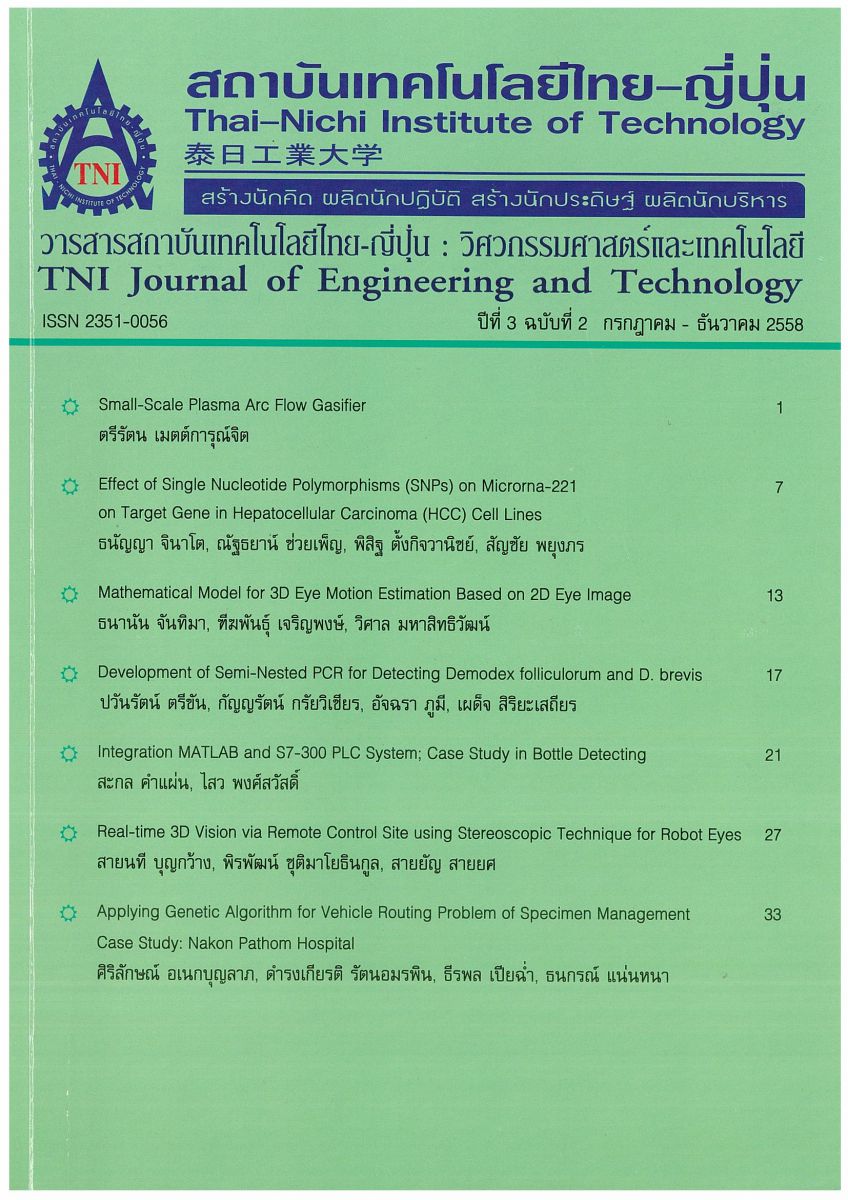Real-time 3D Vision via Remote Control Site using Stereoscopic Technique for Robot Eyes
Main Article Content
Abstract
The remote vision of a rescue robot is still two- dimensional (2D) vision, that is not so efficient because it cannot see the depth of the image. This paper present the real-time three-dimensional (3D) vision via remote control site by using stereoscopic technique for robot eyes. A 3D images will be sent and control from a far distance by looking through the two cameras, this will make it feels like watching in the virtual reality. Display images by real-time 3D stereoscopic technique have several advantages of visualization because the image can be seen depth and virtuality. Thus, the monitor will be presented as the robot eyes in which can be controlled remotely. The experiment showed that there was a delay in a little more control and testing of the 10 people confirmed audience to watch 3D images clearly. And a delay in processing an average of 7.4% compared to the control. The proposed technique can be applied for the visibility that need to be precise such as grabbing stuffs, recovery of explosives, and rescuing human from an earthquakes, so that human doesn’t have to risk his life.
Article Details
Article Accepting Policy
The editorial board of Thai-Nichi Institute of Technology is pleased to receive articles from lecturers and experts in the fields of engineering and technology written in Thai or English. The academic work submitted for publication must not be published in any other publication before and must not be under consideration of other journal submissions. Therefore, those interested in participating in the dissemination of work and knowledge can submit their article to the editorial board for further submission to the screening committee to consider publishing in the journal. The articles that can be published include solely research articles. Interested persons can prepare their articles by reviewing recommendations for article authors.
Copyright infringement is solely the responsibility of the author(s) of the article. Articles that have been published must be screened and reviewed for quality from qualified experts approved by the editorial board.
The text that appears within each article published in this research journal is a personal opinion of each author, nothing related to Thai-Nichi Institute of Technology, and other faculty members in the institution in any way. Responsibilities and accuracy for the content of each article are owned by each author. If there is any mistake, each author will be responsible for his/her own article(s).
The editorial board reserves the right not to bring any content, views or comments of articles in the Journal of Thai-Nichi Institute of Technology to publish before receiving permission from the authorized author(s) in writing. The published work is the copyright of the Journal of Thai-Nichi Institute of Technology.
References
J. Eichenlaub, “A Lightweight, Compact 2D/3D Autostereoscopic LCD Backlight for Games, Monitorand Notebook Application,” in Proceedings of the SPIE, vol. 3295, pp.193-222, Jan, 1998.
ELSA AG, 3D Revelator, Quick start Guide, Aachen, Germany, 1999.
N. Holliman, “3D Display Systems,” to appear, Handbook of Opto-electronics, IOP Press, Spring 2004, ISBN 0-7503-0646-7.
ก้องเกียรติ เรืองไทย วัชระ ฉัตรวิริยะใ 2554. “การปรับระยะภาพสเตอริโอสโคปิคเพื่อการรับรู้ของมนุษย์”., วารสารเทคโนโลยีสารสนเทศ 7, 13 (มกราคม-มิถุนายน)
อาทิตย์ ศรีแก้ว. (2546). โครงการวิจัยเรื่องการพัฒนาหุ่นยนต์ระบบการมองเห็นแบบสเตริโอแอคทีฟในเวลาจริงสำหรับระบบช่วยเหลือคนพิการแบบ.วิทยานินธ์วิศวกรรมศาสตร์มหาบัณฑิต.มหาวิทยาลัยเทคโนโลยีสุรนารี.
นางสาวจุรีลักษณ์ แก้วกลุ่ม นางสาวภูติญา บัวระภา และนายสุรพงศ์ เทียนทอง. 2553. “การมองเห็นของหุ่นยนต์โดยใช้เทคนิคสเตอริโอสโคปิค 3 มิติ”. ปริญญานิพนธ์การศึกษาบัณฑิต ภาควิชาคอมพิวเตอร์ คณะวิทยาศาสตร์ มหาวิทยาลัยขอนแก่น
N. Holliman, “Mapping perceived depth to regions of interest in stereoscopic images,” Displays and Virtual Reality Systems XI, Proceedings of SPIE 5291, 2004.
G. Jones, D. Lee, N. Holliman, and D. Ezraa, “Controlling perceived depth in stereoscopic image,” in Stereoscopic Displays and Virtual Reality Systems VIII, Proceedings of SPIE 4297A, 2001.
G. N. Hiruma, and T. Fukuda, “Accomodation Response to Binocular Stereoscopic TV Images and their Viewing Conditions,” SMPTE Journal, pp. 1137-1144, Dec, 1993.
G. R. Sand, and A. Chiari, es., Stereoscopic Television: Standards, Technology and Signal Processing, European Commission Directorate General XIII-B, Brussels, 1998
Stevens, W. R. 1994. TCP/IP Illustrated, Volume 1: The Protocols. Addison-Wesley.


